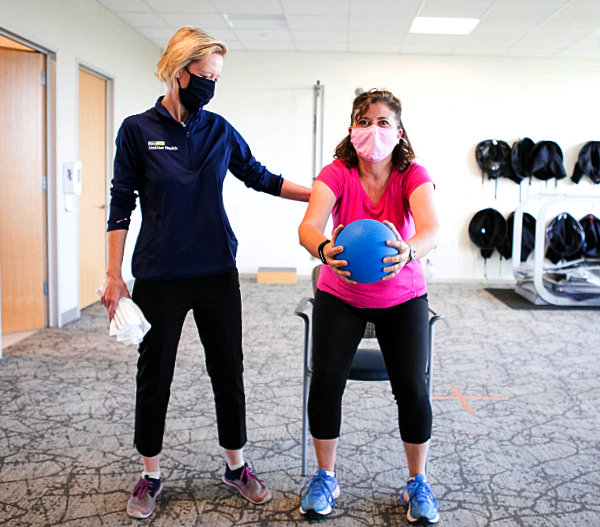
Photo: Sentinel/Clark Brooks
Practicing free-hitting is a valuable way to enhance both the mental and physical aspects of a player's game. Tennis players aiming to improve their consistency, tenacity, and shot tolerance would benefit from dedicating four or more hours each month to focused free-hitting.
What is Free-Hitting?
Free-hitting, at its core, is rallying for the sake of rallying. It’s a type of tennis practice where you’re just hitting the ball back and forth with a partner or alone (using a wall or ball machine), without keeping score or worrying about the outcome of each shot. The goal isn’t to win, but to groove your strokes and get a feel for the ball.
Focusing on muscle memory through controlled repetitions, free-hitting is a training progression that develops consistent, dependable tennis strokes. Properly structured free-hitting sessions improve preparation, swing mechanics, footwork, and shot tolerance, all of which are important for winning more points during a match. Essentially, it involves intensive cooperative rallying between two players, allowing them to achieve a high level of consistency faster and maintain it over time.

Photo: Sentinel/Clark Brooks
Free-hitting helps increases a player's ability to perform well under pressure with confidence. It is a valuable training method that improves both the mental and physical aspects of a player's game.
What makes free-hitting more intense and beneficial than playing games or matches is that you hit more balls in a shorter span of time. In match play, the average rally consists of just four shots, compared to triple that—or more—when free-hitting. Hitting more balls with a focus on swing mechanics and proper footwork not only builds the consistency needed to wear down opponents or force errors, but also enhances shot tolerance, which is the ability to keep the ball in play without mistakes. This also increases a player's ability to perform well under pressure with confidence. The ultimate goal of free-hitting is to make hitting a quality ball to any spot in the opposing court as automatic as picking up a spoon to eat a bowl of soup or using a knife and fork to cut a steak.
"Free-hitting is really really useful for improving your strokes," Tomaz Mencinger says is his
YouTube video from 2017. "I'm not talking about tactics or the mental game which is what competition will help you improve, but when you want to work on your strokes, on the fundamentals on your, contact point, on your weight transfer, on watching the ball and so on - which means mastering your technique, mastering your strokes, or mastering your movement, then free hitting sessions are the best way of working on that."
Compared to regular match play or specific drills like serving or volleying, free-hitting allows for a more fluid, unrestricted type of practice. There’s no pressure to perform perfectly, no drill-based rules to follow, and no need to stick to a certain type of shot.
You can focus on simply hitting the ball, developing rhythm, and experimenting with new swing mechanics or strokes. Free-hitting is a valuable part of improving both the mental and physical aspects of a player's game.

Photo: Sentinel/Clark Brooks
Free-hitting is an excellent training method to try new techniques, spins, or shot selections without worrying about losing a point. You and your training partner can practice the new strategy or tools for your toolbox over and over until you get it right so you can make the shot in a competitive match.
Mental Benefits of Free-Hitting
One of the most significant advantages of free-hitting is its impact on your mental game. Tennis can be mentally taxing, especially when you're constantly under the pressure of performing in matches. The fear of making mistakes or losing can sometimes lead to tight, tentative play. Free-hitting eliminates this pressure altogether.
- Boosts Confidence and Reduces Anxiety
When you take away the stress of point-scoring and winning, you allow your mind to relax. Free-hitting helps players rebuild confidence by enabling them to focus on hitting solid, clean shots. With no pressure to win, players can concentrate on pure enjoyment of the game, which helps improve mental clarity and reduces anxiety. This relaxed state often leads to an improved performance later when stakes are higher in matches.
- Promotes Mental Focus and Rhythm
Tennis is as much a mental game as it is a physical one. Free-hitting is the perfect opportunity to focus on your rhythm. The repetition of strokes without a time constraint allows you to settle into a flow state, where concentration is heightened, and distractions fade away. Players can build focus as they continually rally, fostering mental discipline that can be transferred to high-pressure match situations.
- Encourages Experimentation and Creativity
Since there's no consequence to missing shots, players feel more inclined to experiment with their game. Maybe you’ve been hesitant to practice that topspin backhand in a match setting, or you’ve avoided going for risky down-the-line winners. During free-hitting, you can try out new techniques, spins, or shot selections without fear of judgment or failure. This freedom encourages creativity, which can lead to discovering new strengths in your game.
Technique and Skill Improvement
While the mental benefits of free-hitting are clear, its role in improving technique should not be underestimated. The unstructured nature of free-hitting allows players to isolate and focus on various aspects of their game.
- Developing Muscle Memory
Repetition is key to mastering any skill in tennis, and free-hitting is an ideal method for building muscle memory. Because there’s no need to rush, players can take their time to groove their strokes, perfecting their form on groundstrokes, volleys, or even serves. By continually repeating these motions, the body learns to execute these shots more fluidly and consistently under pressure.
- Shot Refinement and Consistency
Free-hitting gives players the space to fine-tune the technical aspects of their shots. You can spend time working on your forehand, backhand, or serve without the interruptions or constraints of match play. This kind of repetition helps players develop a solid foundation for consistency, a critical factor in tennis. The more time you spend hitting with rhythm, the more you reinforce good habits that will serve you well in competitive scenarios.
- Footwork and Timing
One often overlooked benefit of free-hitting is its positive impact on footwork. With less focus on the outcome of each shot, players can pay closer attention to their positioning and movement. Working on footwork becomes easier when you're not distracted by the pressure of winning points. Whether you're practicing your split step, recovering after a shot, or positioning yourself for the next ball, free-hitting gives you the freedom to perfect these movements.
- Adaptability
Free-hitting exposes you to various types of shots at different speeds and angles, honing your ability to adjust. It’s an opportunity to improve your reaction time and adaptability, which are crucial skills during real matches. By engaging in rallies where the ball could come from unexpected directions, you build the reflexes needed to handle different opponents’ styles.

Photo: Sentinel/Clark Brooks
One of the biggest mistakes players make when free-hitting is starting from the baseline. Instead, play mini-tennis using full strokes until you and your partner can consistently hold 50+ hit rallies. In addition to allowing players to get in more quality reps, long short-court rallies are essential in building shot tolerance, tenacity, and consistency.
The free-hit training progression starts with
short-court hitting. The goal is to hit the ball back over the net inside the service line, using only the middle third of the court, creating extended rallies that last 25 or more combined shots.
Remember, this is a cooperative exercise. Players are not keeping score or trying to win points. The objective is to hit the ball consistently enough that you can achieve a 50-shot rally without errors, using full strokes on a regular basis.
If your partner hits too aggressive a stroke or hits the ball outside the middle third, get the ball back over the net. Volley, short lob, or slice it back into play—you'll be doing that in a match anyway. The goal is to adapt to the bad ball, reset the rally and keep a controlled rally going. To be honest, if your unit turn is early and you’re split-stepping, the occasional non-cooperative ball won't be an issue.
When you and your partner can consistently perform three 50-shot rallies or more, that is your cue to move back to the region of the court known as "no-man's land." From there, repeat the same process with the same parameters until you and your partner can consistently maintain three or more 30-shot rallies. Only after that should you move back behind the baseline and repeat the process,
aiming for rallies of 15 or more shots.
Incorporating free-hitting into your regular tennis practice routine is essential for both recreational and competitive players. Over just a few weeks of consistent practice, you will experience noticeable improvements in your on-court performance, including enhanced footwork, reduced unforced errors, and increased ability to sustain points. Free-hitting provides a enjoyable and low-pressure opportunity to refine specific techniques and address weaknesses, leading to overall improvement in your tennis game and increased success in matches.
Feel the Rush!


























